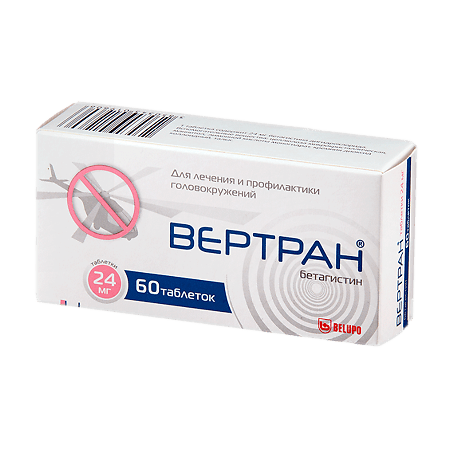No products in the cart.
Vertran, 24 mg tablets 60 pcs
€14.11 €12.35
Description
An agonist of H1-histamine receptors of the inner ear vessels and an antagonist of H3-histamine receptors of the vestibular nuclei of the central nervous system (CNS).
It has no effect on H2-histamine receptors, which improves blood circulation in the vascular band of the inner ear due to the relaxing effect on the pre-capillary sphincters of the cochlea and labyrinth.
Relieves symptoms of Meniere’s syndrome and vertigo.
Indications
Indications
Meniere’s syndrome, characterized by the following main symptoms:
– dizziness (accompanied by nausea/vomiting)
– hearing loss
– tinnitus
Symptomatic treatment and prevention of vestibular dizziness (vertigo) of various etiologies.
Pharmacological effect
Pharmacological effect
An agonist of H1-histamine receptors in the vessels of the inner ear and an antagonist of H3-histamine receptors of the vestibular nuclei of the central nervous system (CNS).
It does not affect H2-histamine receptors, which improves blood circulation in the vascular stria of the inner ear due to its relaxing effect on the precapillary sphincters of the cochlea and labyrinth.
Relieves symptoms of Meniere’s syndrome and vertigo.
Special instructions
Special instructions
Impact on the ability to drive vehicles and machinery
Based on the results of clinical studies, it is believed that the effect of betahistine on the ability to drive a car and other mechanisms is absent or insignificant, since no effects potentially affecting this ability were detected.
Active ingredient
Active ingredient
Betahistine
Composition
Composition
1 tablet contains:
Contraindications
Contraindications
Hypersensitivity to any of the components of the drug. Due to insufficient data on effectiveness and safety: pregnancy and lactation; age up to 18 years.
With caution
Betahistine should be prescribed with caution when treating patients with a history of gastric and duodenal ulcers. Patients with pheochromocytoma and bronchial asthma should be regularly monitored by a doctor during treatment.
Side Effects
Side Effects
From the gastrointestinal tract: often (from >1/100 to <1/10) - nausea and dyspepsia.From the nervous system: often (from >1/100 to <1/10) - headache.In addition to these effects identified during clinical trials, the following side effects have been reported during post-marketing use and in the scientific literature (the available data are insufficient to estimate their frequency):From the gastrointestinal tract: moderate disorders such as vomiting, pain in the gastrointestinal tract, bloating. As a rule, these effects disappear if the drug is taken simultaneously with food or after a dose reduction.From the skin and subcutaneous fat: angioedema, urticaria, itching and rash.On the part of the immune system: hypersensitivity reaction, including anaphylactic reactions have been reported.
Interaction
Interaction
In vivo studies aimed at studying interactions with other drugs have not been conducted. Based on in vitro data, it can be assumed that there is no inhibition of the activity of cytochrome P450 isoenzymes.
When used simultaneously with H1-histamine receptor blockers, the therapeutic effect of betahistine may be reduced.
Overdose
Overdose
Symptoms: after taking the drug in doses up to 640 mg, mild to moderate symptoms (nausea, drowsiness, abdominal pain) may be observed. More serious complications (eg, seizures, cardiopulmonary complications) may occur when taking higher doses of betahistine, especially in combination with other drugs.
Treatment: symptomatic.
Patients with pheochromocytoma should use the drug under medical supervision.
Recommendations for use
Recommendations for use
Inside, during meals.
The dose of the drug is:
Tablets 24 mg: 1 tablet. 2 times a day.
The maximum daily dose is 48 mg.
The dose and duration of treatment should be individualized depending on the patient’s response to treatment.
Improvement is usually noted at the beginning of therapy, but it can be gradual and appear even after several weeks of treatment. A stable therapeutic effect in some cases is achieved after several months of treatment.
Dose adjustment is not required in elderly patients, as well as in patients with renal and/or liver failure.
Functional features
Functional features
When taken orally, it is quickly and completely absorbed from the gastrointestinal tract.
Plasma protein binding is low (less than 5%). The maximum concentration in the blood plasma (Cmax) is reached after 1 hour. When taking the drug with food, the maximum concentration of the drug in the blood is lower than when taken on an empty stomach, however, the total absorption of betahistine is the same in both cases, which indicates that food intake only slows down the absorption of betahistine. Metabolized in the liver to form the inactive metabolite 2-pyridylacetic acid.
Almost completely (90.7%) is excreted by the kidneys in the form of a metabolite (2-pyridylacetic acid) within 24 hours. The half-life is 3-4 hours. The elimination rate remains constant, indicating the linearity of the pharmacokinetics of betahistine.
Storage conditions
Storage conditions
At a temperature not exceeding 25 °C.
Manufacturer
Manufacturer
Belupo, medicines and cosmetics d.d., Croatia
Additional information
| Conditions of storage | At a temperature not exceeding 25 °C. |
|---|---|
| Manufacturer | Belupo,medicines and cosmetics d.d., Croatia |
| Medication form | pills |
| Brand | Belupo,medicines and cosmetics d.d. |
Related products
Buy Vertran, 24 mg tablets 60 pcs with delivery to USA, UK, Europe and over 120 other countries.













